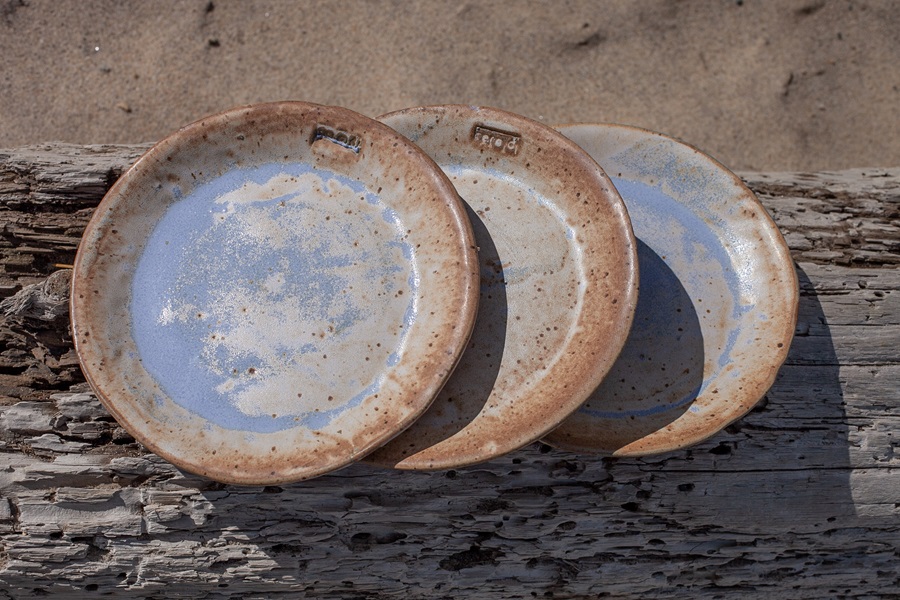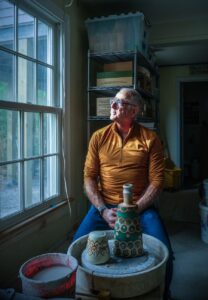The Outer Cape has provided the bedrock of inspiration for ceramicists Michael Ceraldi, Paul Wisotzky, and Isabel Souza. Ceraldi takes creative nourishment from this place most literally, gathering clay from local beaches to create plates for his Wellfleet restaurant. As young ceramicists, Souza and Wisotzky both nurtured their craft at Castle Hill, where Ceraldi currently creates and fires his work. They share a commitment to making functional objects, but that’s about where the similarities end. These three artists have forged different styles, revealing the malleability of the art form.
Michael Ceraldi
“I try to live from a creative, artistic place. That’s my home. I’ve always been working in food and making art. Rolling out clay with the slab roller and rolling out pasta with my pasta machine are pretty much the same thing.

“When I started doing ceramics here, I heard about the clay deposits at the beach and I thought about how I could incorporate the actual earth we’re standing on into my work. I started harvesting about a half pound of clay at a time and turning that into a slip, which is like a thick, loose paint with which I’ll coat my plates. The local clay is a deep gray because of the iron it contains, but when it’s fired it turns an oxidized, rusty color.

“I like to keep the somewhat irregular characteristics of each piece I make, because that’s a good representation of the earth and where it comes from. I don’t want to take that away by trying to laboriously make every edge perfect. I’m inspired by Japanese ceramics that don’t try to hide what some people might consider mistakes.”
Paul Wisotzky
“I started making pots when I was at Lexington High School. I had a great teacher. She was the first teacher who showed me that I could actually be good at something. My parents had a summer home in Truro, and I started taking classes at Castle Hill when I was a teenager. I did it in college a little bit, but I stopped, and I had another life for 20 or 25 years.”
“I always wanted to be a potter. I moved here in 2007. Now’s the time, I thought, and I did it.

“I glaze my work in atmosphere kilns, which is where the atmosphere has an impact on the glaze surface and the clay surface. One of the things I love about atmospheric firing is that it gives the kiln the last say. I can’t control the atmosphere consistently, so it will impact the surface of the pot differently in each firing. Most of the time, it’s a good final say, but occasionally it’s not — that’s the beauty of it.

“I have a specific decorating technique. I’m inspired by looking at patterns on fabric, in architecture, or in graphic design. I design sponge stamps on the computer and fabricate them with a laser cutter. I then use the sponge stamps to decorate my pottery through wax resist, kind of like batik.”
Isabel Souza
“Ceramics was always a thing for me. I’ve never taken a break from it. I’ve always been determined to make this my full-time job.
“I was in kindergarten when I took my first handbuilding clay class at Castle Hill, and then in fifth grade I took my first throwing class. I continued through high school and then college and now I’ve been selling my work for four years.

“I have all these mugs that I’m working on for my shop that’s opening in Wellfleet in the spring. My goal is to make 1,500 mugs this year. I threw 80 mugs yesterday. When I’m making this many mugs it’s important for me to have a design that I know will turn out well. I have this blue-splatter design inspired by vintage enamelware. It’s a white opaque glaze with blue on top of it. My grandmother has a blue and white enamel bowl that we always used to eat popcorn out of, so it’s very nostalgic for me.

“I’m inspired by Portuguese and Spanish pottery. I use a European technique called maiolica but apply it in a different style. The technique begins with a base glaze that’s a really opaque white and then I paint pigments on top of it. If you’re just using normal glazes, it’s harder to get the same details. Maiolica lends itself to bright colors and imagery.”



